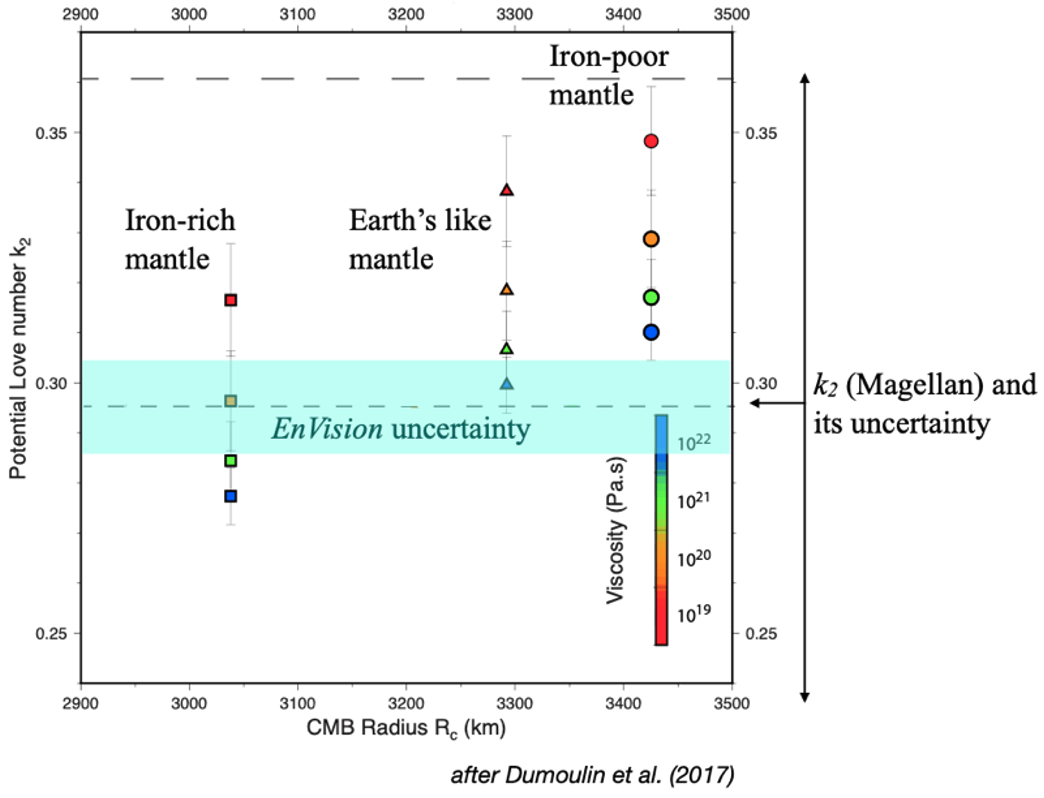Page updated 1 June 2021 – Author: Dr. Caroline Dumoulin
1. EnVision : mapping the local gravity field
Any orbiting spacecraft is sensitive to the local gravity field, plus the gravity field of the Sun and, to a minor extent, of the other planets. These gravitational perturbations, generate spacecraft orbital velocity perturbations from which the gravity field of a planet can be determined at a spatial resolution which depends on the orbital altitude: the lower the altitude, the better the resolution. This low-altitude has to be performed everywhere over the planet to determine the expected high-resolution gravity field, hence a near-circular and near-polar orbit is preferable. It was not fully the case with the Magellan mission which had elliptical orbits to solve for the gravity field harmonics and only 3 cycles of tracking data, leading to uneven resolution over longitude and latitude. Another limitation of low-altitude orbit for the gravity field is the atmospheric drag which perturbs the resolution of gravity harmonics primarily because the density of the high-altitude atmosphere (the thermosphere) is highly variable. The lowest altitudes reached by Magellan orbits were significantly affected by the drag below about 200 km altitude. The low-excentricity, near-polar and relatively low altitude (220-515 km) orbit of EnVision offers the opportunity to obtain a high-resolved gravity field (better than 200 km, see figure below) at each longitude and latitude of the Venusian globe (Rosenblatt et al., 2021). The analysis of the gravity field together with the topography gives insights on the lithospheric and crustal structure, allowing to better understand Venus’ geological evolution.

Degree strength / spatial resolution map expected after six cycles from EnVision simulations (right) vs Magellan/PVO results (left). Click on Figure to enlarge.
2. Tidal deformation
In the absence of seismic data, the measurements of the tidal deformation and proper motion of the planet provide the way to probe its deep internal structure (size and state of the core). The tidal deformation can be measured in the EnVision orbital velocity perturbations through the gravitational potential variations it generates (so-called k2 tidal Love number).

Expected k2 Love number in function of core radius for different models of mantle composition and viscosity. The actual value with its uncertainty is displayed on the right side. The required accuracy for EnVision is shown with the blue area, assuming the same k2 value (modified from Dumoulin et al., 2017).
3. Sounding the neutral atmosphere and ionosphere of Venus
EnVision’s communication system will also be used for sounding the neutral atmosphere and ionosphere of Venus, during the frequent occultations that occur during the communications links. As the spacecraft starts to be occulted by the planet, the spacecraft carrier signal to the Earth probes the layers of the planet’s atmosphere, causing changes in the frequency and amplitude of the carrier waves (at X- and Ka-bands). The bending that occurs through atmospheric refraction can be retrieved from the Doppler shift residual obtained during the occultation event, with accurate estimates of the spacecraft state vectors. By determining the dependence of the signal bending angle with respect to altitude (more precisely the impact parameter which is related to the refractivity coefficient), profiles of the neutral atmosphere and plasma densities can be derived, essential for characterizing the atmospheric structure and dynamics: By probing the neutral atmosphere above ~ 45 km, density, temperature and pressure profiles can be derived to characterize the atmospheric dynamics and its longitudinal and latitudinal as well as local time variations. When conducting this experiment, coherent dual-frequency transmission (X- and Ka-band) is desirable in order to separate the nondispersive from the dispersive media effects, both to distinguish the neutral atmosphere from the ionosphere, and also to reduce the propagation noise of the tracking observables from solar corona and solar wind effects. The experiment will be conducted in two/three-way mode, as required for navigation purposes so that normally ingress profiles will result from the experiment.
The use of Ka-band will provide for the first time the opportunity to distinguish between gaseous and liquid (droplets) sulfuric acid concentration in the atmosphere of the planet (at about 45-55 km altitude). This unique measurement of gaseous vs liquid compound of sulfuric acid is a decisive observation to constrain the SO2 volcanic gas cycle into the atmosphere, and in turn the current geologic activity of Venus.
